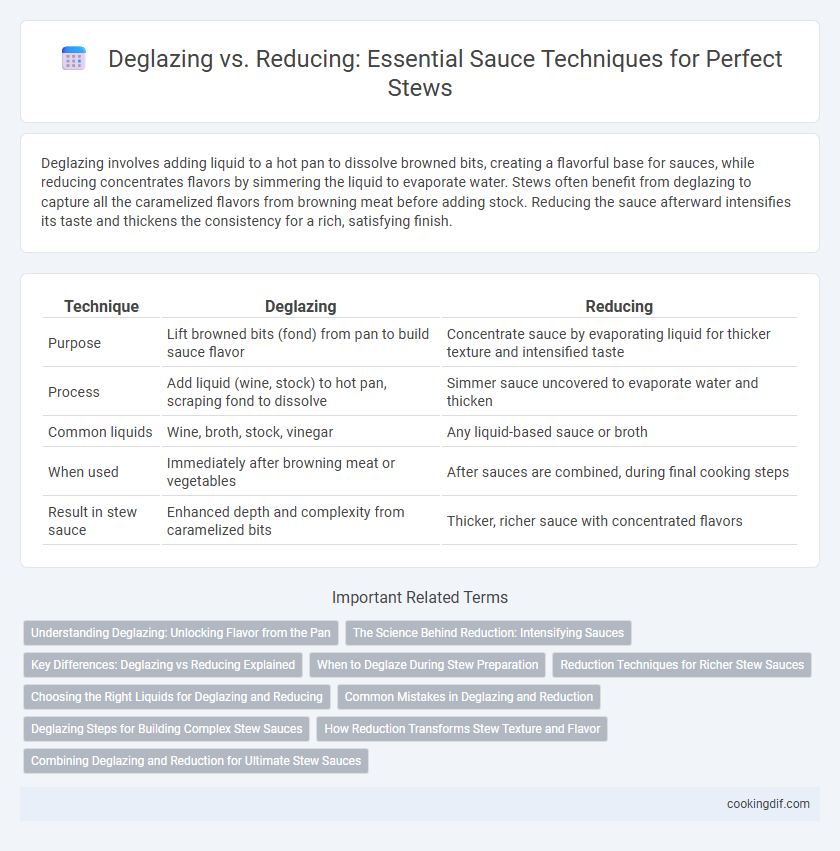Deglazing involves adding liquid to a hot pan to dissolve browned bits, creating a flavorful base for sauces, while reducing concentrates flavors by simmering the liquid to evaporate water. Stews often benefit from deglazing to capture all the caramelized flavors from browning meat before adding stock. Reducing the sauce afterward intensifies its taste and thickens the consistency for a rich, satisfying finish.
Table of Comparison
| Technique | Deglazing | Reducing |
|---|---|---|
| Purpose | Lift browned bits (fond) from pan to build sauce flavor | Concentrate sauce by evaporating liquid for thicker texture and intensified taste |
| Process | Add liquid (wine, stock) to hot pan, scraping fond to dissolve | Simmer sauce uncovered to evaporate water and thicken |
| Common liquids | Wine, broth, stock, vinegar | Any liquid-based sauce or broth |
| When used | Immediately after browning meat or vegetables | After sauces are combined, during final cooking steps |
| Result in stew sauce | Enhanced depth and complexity from caramelized bits | Thicker, richer sauce with concentrated flavors |
Understanding Deglazing: Unlocking Flavor from the Pan
Deglazing involves adding a liquid such as wine, broth, or vinegar to a hot pan to dissolve and lift the flavorful browned bits known as fond, which form during searing or browning meat for stew. This technique intensifies the sauce by incorporating concentrated caramelized flavors that enhance the depth and complexity of the dish. Understanding how to deglaze properly ensures that the sauce captures these rich, savory elements rather than wasting them, setting it apart from reducing, which primarily concentrates liquids by evaporation.
The Science Behind Reduction: Intensifying Sauces
Reduction involves simmering a stew's liquid to evaporate water, concentrating flavors and thickening the sauce through the evaporation of volatile compounds and water content. Deglazing, by contrast, uses a liquid--often wine or stock--to dissolve browned bits (fond) from the pan, adding depth without significant volume loss. The science behind reduction enhances taste by increasing the density of dissolved solids, sugars, and acids, creating a richer, more intense sauce essential in stews.
Key Differences: Deglazing vs Reducing Explained
Deglazing involves adding a liquid such as wine, broth, or vinegar to a hot pan to dissolve browned food residues, creating a flavorful base for sauces. Reducing is the process of simmering or boiling a liquid to evaporate water content, concentrating flavors and thickening the sauce. The key difference lies in deglazing extracting flavors from cooked solids while reducing intensifies and thickens the sauce by evaporation.
When to Deglaze During Stew Preparation
Deglazing should be performed immediately after browning meat in stew preparation to dissolve fond and capture concentrated flavors for the sauce. This technique unlocks caramelized bits from the pan, creating a rich base before adding liquids and simmering. Reducing, on the other hand, occurs later during slow cooking to thicken and intensify the sauce by evaporating excess moisture.
Reduction Techniques for Richer Stew Sauces
Reduction techniques concentrate on simmering stew liquids to evaporate excess water, intensifying flavors and thickening the sauce naturally. Deglazing involves adding liquid to the hot pan to dissolve browned food residues, enhancing depth and complexity in the sauce base. Combining careful reduction after deglazing maximizes flavor concentration, resulting in richer, more robust stew sauces.
Choosing the Right Liquids for Deglazing and Reducing
Selecting the right liquids for deglazing or reducing greatly influences the depth and balance of stew sauces, with wine, stock, and vinegar offering distinct acidity and flavor profiles essential for enhancing savory notes. Deglazing typically requires liquids that quickly dissolve browned bits without overpowering the dish, such as dry white or red wine, broth, or sherry, while reducing benefits from thicker, more concentrated liquids like demi-glace or reduced stock to intensify sauce richness. Understanding the balance between acidity, sweetness, and umami in your chosen liquids ensures a harmonious, flavorful sauce that complements the stew's ingredients.
Common Mistakes in Deglazing and Reduction
Common mistakes in deglazing include adding liquid to a too-cold pan, which fails to lift flavorful fond, and using excessive liquid that dilutes the sauce's intensity. In reduction, overcooking can cause the sauce to become overly thick and overly salty, while insufficient simmering results in a watery, underdeveloped flavor. Proper temperature control and timing are essential to balance concentration and prevent bitter or burnt notes in both techniques.
Deglazing Steps for Building Complex Stew Sauces
Deglazing involves adding a liquid, such as wine, broth, or water, to the hot pan after browning meat, which lifts and dissolves the flavorful browned bits called fond from the bottom of the pan. This technique introduces depth and complexity by incorporating these caramelized residues into the stew sauce, enhancing both aroma and umami taste. Careful temperature control during deglazing prevents burning and ensures that the resulting sauce maintains a rich, balanced flavor profile ideal for hearty stews.
How Reduction Transforms Stew Texture and Flavor
Reduction intensifies stew by evaporating excess liquid, concentrating flavors, and thickening the sauce for a richer, silkier texture. This process deepens umami notes and balances seasoning, creating a more robust and satisfying mouthfeel. Unlike deglazing, which dissolves browned bits to add brightness, reduction develops complexity through slow simmering and flavor integration.
Combining Deglazing and Reduction for Ultimate Stew Sauces
Deglazing captures the concentrated flavors by dissolving browned bits from the pan using wine, broth, or vinegar, forming a rich base for stew sauces. Reduction intensifies the sauce by simmering the liquid to evaporate excess water, thickening the texture and enhancing taste complexity. Combining deglazing with reduction creates deeply flavorful, thickened stew sauces that elevate the overall dish with balanced acidity and robust savory notes.
Deglazing vs Reducing for sauce technique Infographic

 cookingdif.com
cookingdif.com